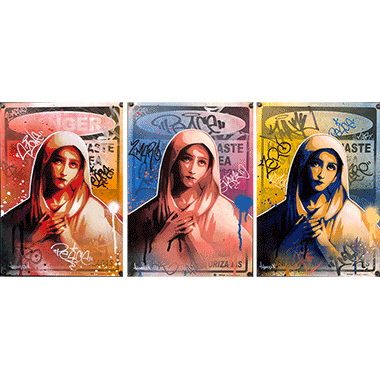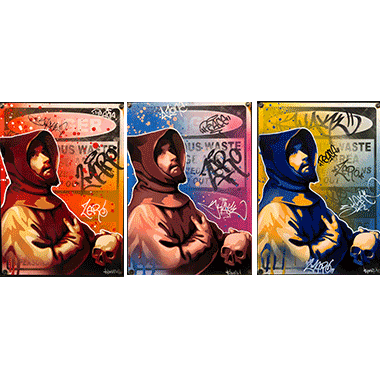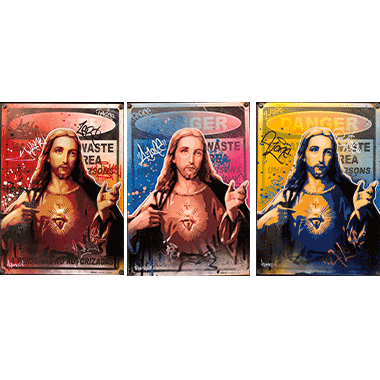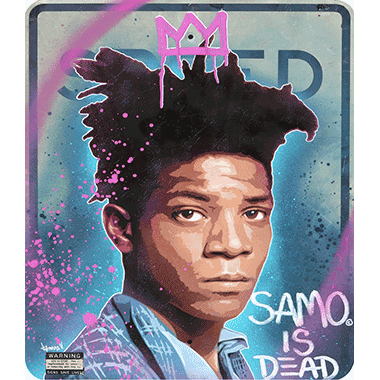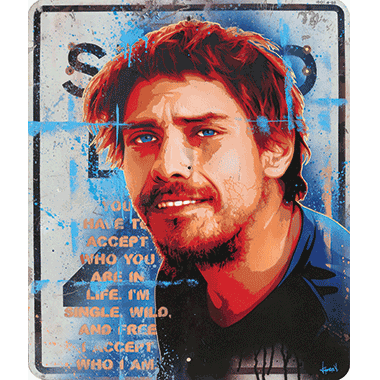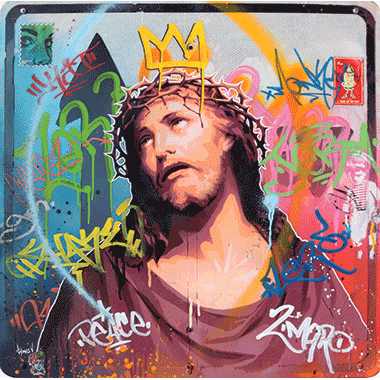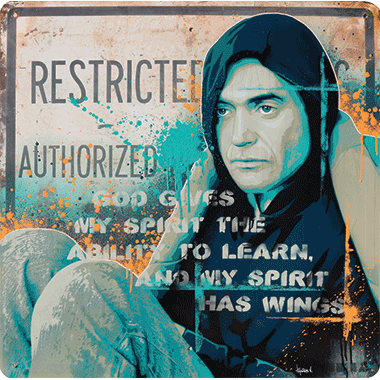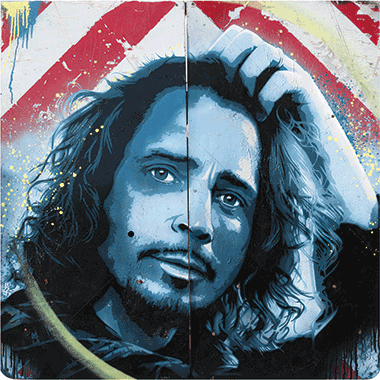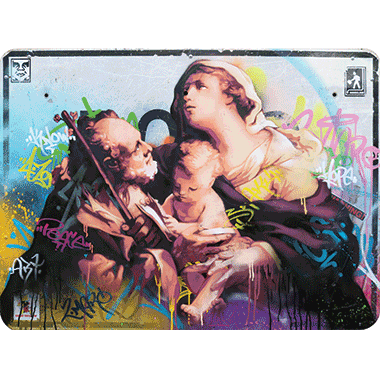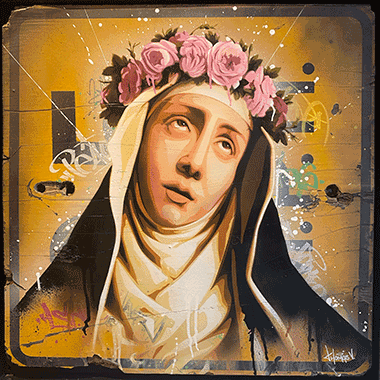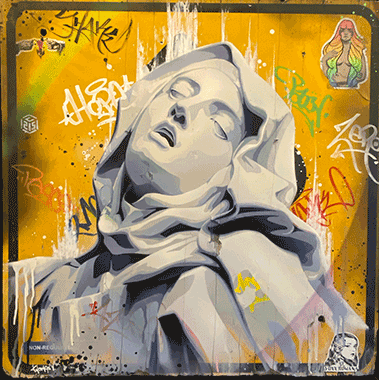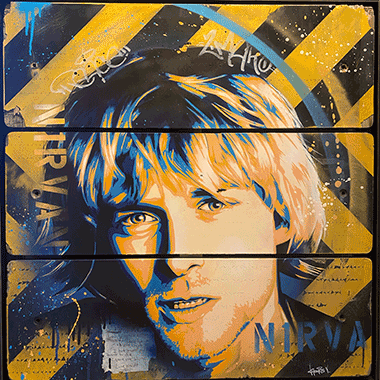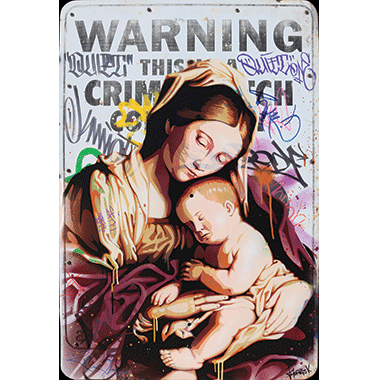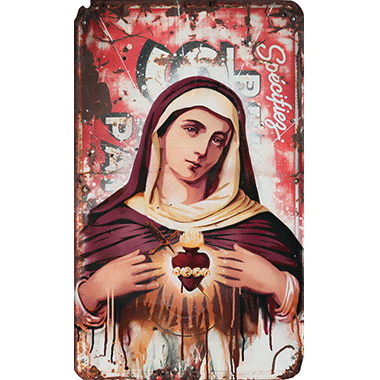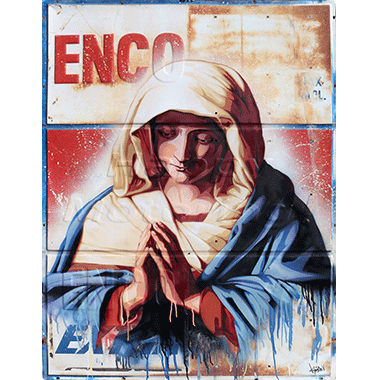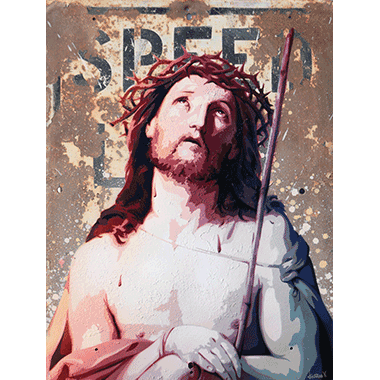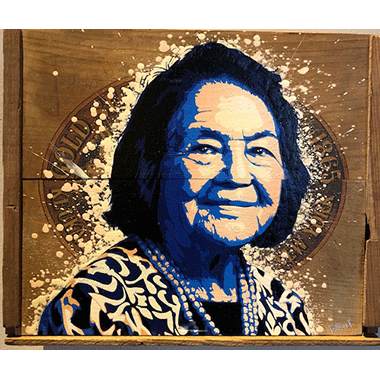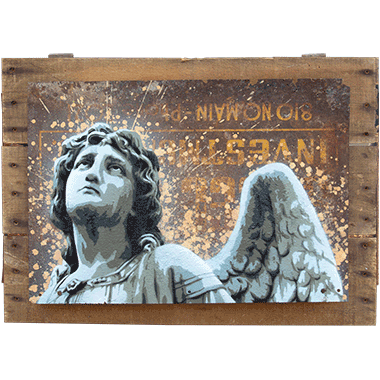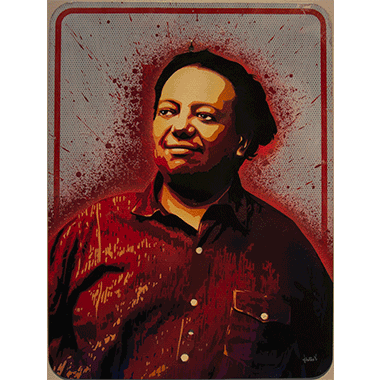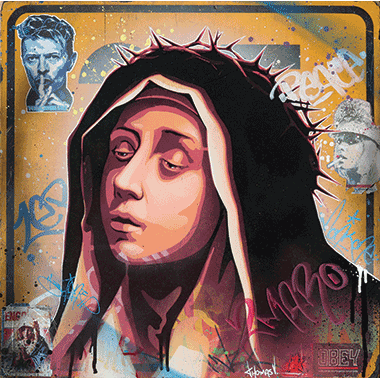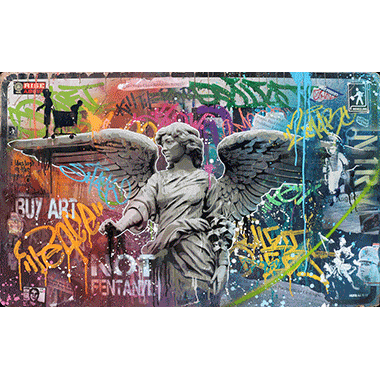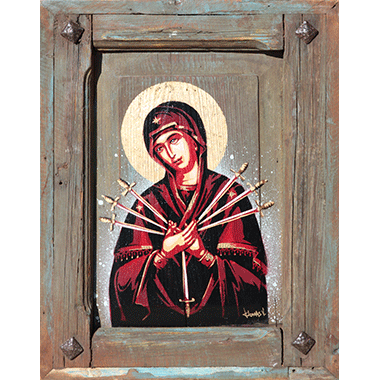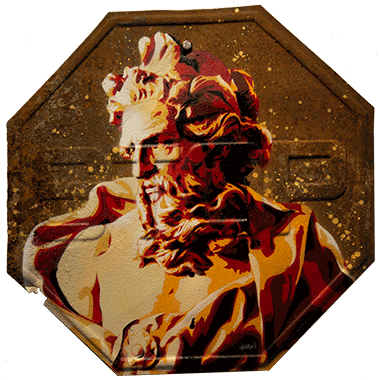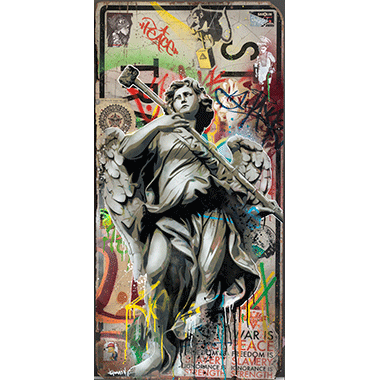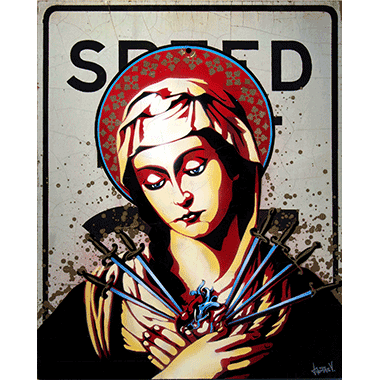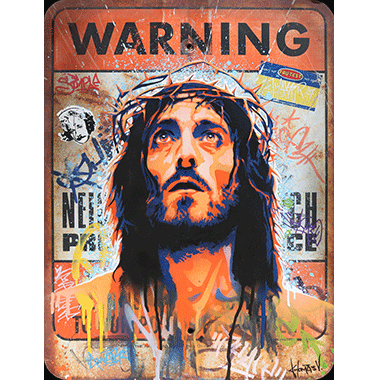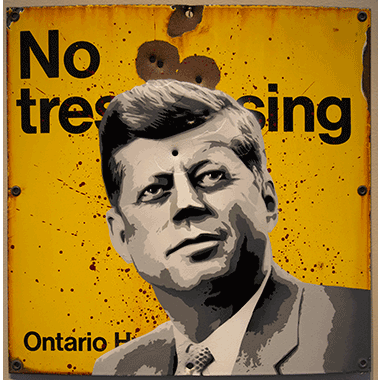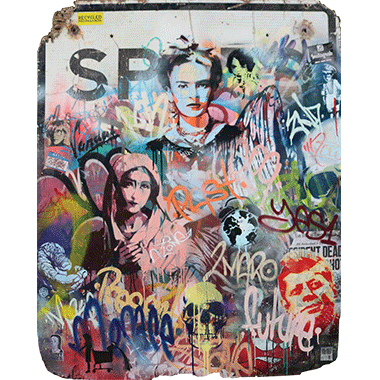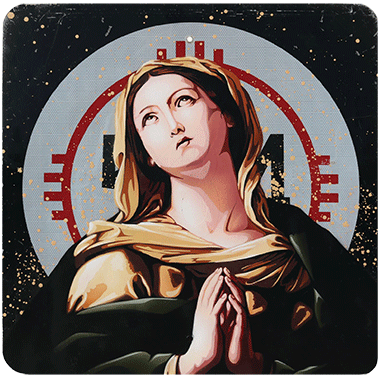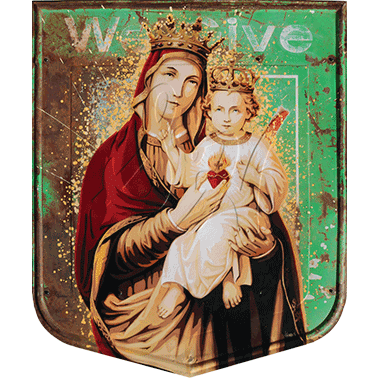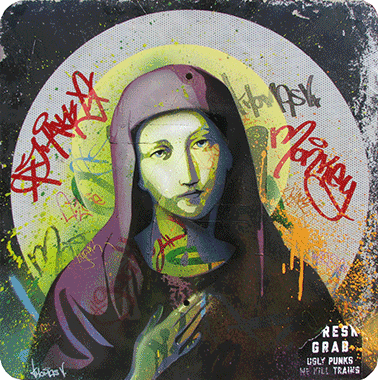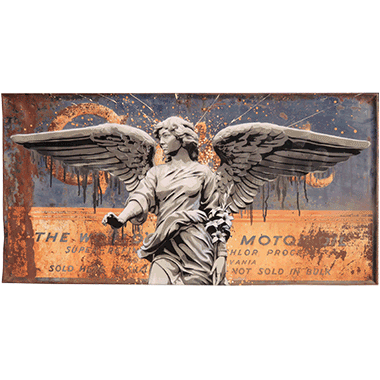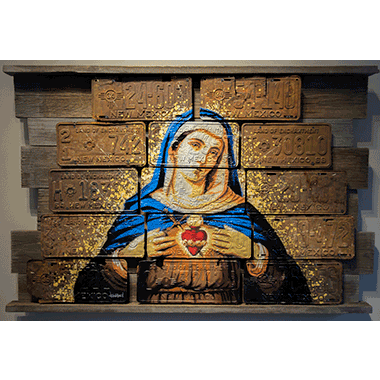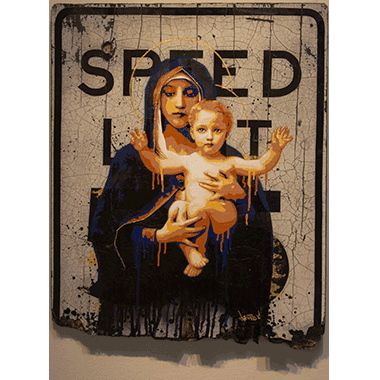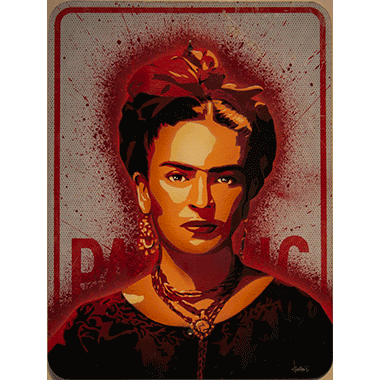THOMAS VIGIL
About Thomas Vigil
“My artwork has always been a constant pursuit to find a harmony between my cultural, religious beliefs and my love for controversial, lowbrow art forms.” So says New Mexico artist Thomas Vigil, who lifts sacred figures from the western art canon and drops them into the contemporary arena, creating striking juxtapositions between high and low, accepted and discarded objects and imagery. As he has made the journey from street to studio artist, the emerging painter has learned to effectively mingle influences ranging from soulful graffiti to Renaissance oil painting to present thoughtful, accessible combinations of otherwise disparate elements.

(continued)
“I’ve had a natural need to create artwork for as long as I can remember,” says Vigil. Born and raised in Española, New Mexico, he was surrounded by a closely connected community rich in the area’s culture and religion, and consequently, continually exposed to the artwork that espoused those ideals. Depictions of the Holy Family and other Christian icons were common, not only in the context of church, but as they filtered into everyday life. As such, they became deeply engrained in Vigil’s identity as both person and artist.
Growing up, Vigil took the requisite art courses in school, but nevertheless craved more intense instruction. Because he was the only member of his family interested in drawing, he sought out additional opportunities on his own, participating in community-based art programs and devouring books and other graphics-oriented media. “I found resources and joined programs because I really liked art,” he explains. This independence and drive would serve him well, throughout his youth and into his career.
As a teenager, Vigil had a creative epiphany of sorts when he visited his older brother in Los Angeles. As he explored the unfamiliar urban neighborhoods, he quickly became acquainted with the most sophisticated street art he had ever encountered. Though he had seen some graffiti in his hometown, what he discovered in California clarified his vision and called to him on a deeper level. He started experimenting with spray paint after that, and soon found himself among a network of knowledgeable street artists, once again mining the resources at hand to broaden his artistic scope and technique. “I learned both on the classroom side and in the streets,” he says. “That’s where my style and my methods came from.”
Vigil went on to attend Northern New Mexico College, where he studied graphic design and art history, ultimately earning an associates degree in applied science in visual communications. He continued to hone his fine art practice during this time, turning to traditionally painted landscapes, religious figures, and local vignettes. Yet despite his turn to conventional processes, the passion for graffiti—what he considered the purest art form—never quite left him. Before long, he was exhibiting paintings in numerous exhibitions and juried shows, yet at the same time felt as if he hadn’t fully achieved what he was trying to express as an artist. “It felt forced to me. It didn’t seem natural at all,” he says. In an attempt to return to his roots, Vigil incorporated spray paint into his acrylic pieces. While the broader materials did move him forward, he still didn’t feel completely engaged by the process. Finally, after several years, he embarked on a creative paradigm shift and converted his work entirely to spray paint, first on canvas, and then on the embattled signs featured in his current work. At last, Vigil had found his niche.
Today, he continues his foray into the fusion of high-art images with common, familiar objects. He paints on recycled materials, most frequently old street signs, in addition to license plates, wood crates, and other found objects. He is especially drawn to old metal signs that have been tagged with spray paint, marked up, dented, or even shot at, for in these cases the signs come with a distinct story evidenced by the visual patina of age, existence, and survival.
Vigil routinely appropriates subjects of old-world paintings as well, including classical or Renaissance depictions of the Virgin Mary, Jesus, and various Catholic saints. “I’ve always been drawn to religious imagery,” says the artist, who grew up in the Catholic Church, and in adulthood has retained its spiritual essence and call to do good works. “I believe that religion is a good thing. It doesn’t matter what type of religion you believe in, I think that the main purpose of it is to be a good person.” All this has made its way into his art, in layers of religion and history set against the backdrop of contemporary urban living. Likewise, Vigil’s work features cultural champions of the modern age, such as César Chavez and Frida Kahlo. Combined, the iconic subjects and commonplace supports embody complex cultural strata that also function as a manifestation of time.
Vigil fabricates his own stencils to reproduce the historical paintings and sculptures that catch his eye. He then applies color with spray paint, meticulously blending the pigments to infuse shading and nuance into each composition. Often regarded as the medium of amateur street artists, spray paint has become increasingly refined in the recent past, with more than 250 colors available in cans featuring nozzles with adjustable pressure and capable of producing lines of varying widths and strengths. In using spray paint exclusively, Vigil had undoubtedly contributed to the elevation of the medium within the fine art sphere.
Though Vigil has long since given up street art, he remains interested in the ephemeral nature of graffiti, intrigued by the power it holds momentarily as the unique expression of one individual. He finds inspiration in graffiti’s purity of form and intent, and asserts that the often-anonymous works are not about recognition, but about delivering art to the public, and reflective of a person’s most fundamental desire to express. He considers graffiti the ultimate form of art for art’s sake.
Because his art addresses the complex relationship between self-realization and aesthetic expression, Vigil is invested conjuring something greater than simple visual engagement with viewers. “It’s about evoking feelings more than anything,” he remarks. To that end, a visceral or intuitive response, whether positive or negative, not only validates the work for Vigil, but also brings it to life.
By Elizabeth L. Delaney
Education
Associates of Applied Science in Visual Communications from Northern New Mexico College
2024
Looking and Seeing. Thomas Vigil: Know Way, Know Truth, Know Life. John O’Hern
Santa Fe Reporter. Three Questions with Multi-Media Artist Thomas Vigil. Adam Ferguson
2023
Evokation. Lost Prophets: Thomas Vigil. Kelly Kopek
Mutual Art. Thomas Vigil: Lost Prophets
2021
Evokation. Los Tres Modernos: A Santero Tradition Reenvisioned. Susan Guevara
Graff.Funk. Canvas by Thomas Vigil
2020
Trend Magazine. Making Their Marks. Kathryn M. Davis
Albuquerque Journal. Artists Send Hopeful Messages with Works. Kathaleen Roberts
Pasatiempo. Thomas Vigil at EVOKE Contemporary. Michael Abatemarco
2019
New Mexico PBS. “¡Colores!”: Interview with Thomas Vigil
Pasatiempo. Thomas Vigil, Restoration of Innocence (2019), oil on vintage metal sign
2018
New Mexico Magazine. Made in New Mexico. Gwyneth Doland
Videos
YouTube Channel. Thomas Vigil, The Creative Process






